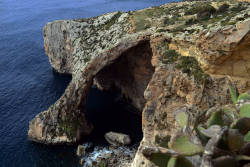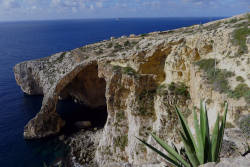Il-Ħnejja
Blue Grotto - The Arch - Sudika Il-Hnejja
Useful Information


| Location: |
Triq Wied Iż-Żurrieq, Iż-Żurrieq, Malta.
2 km southeast of Iż-Żurrieq. (35.8211884, 14.4566207) |
| Open: |
no restrictions. Boats: all year daily 9-16. [2025] |
| Fee: |
Boat trip: Adults Lm 2.50, Children Lm 1.25. [2025] |
| Classification: |
 Karst Cave Karst Cave
 Sea Cave Sea Cave
 Blue Grotto Blue Grotto
|
| Light: | n/a |
| Dimension: | H=43 m. |
| Guided tours: | visited by boat from the sea, D=50 min. |
| Photography: | allowed |
| Accessibility: | no |
| Bibliography: |
Joseph Zammit (1978):
A Superb View Of The Blue Grotto....,
with the Drama of the Shark, the dive, and the storm. 32 pp, 14 photos. A good detailed account of both the Blue Grotto and the many other caves in the area. |
| Address: |
Joseph Galea, Tel: +356-21685172, Tel: +356-79640058.
Carmel Farrugia, Tel: +356-21680660, Tel: +356-79680660. Ticket Boot, Tel: +356-21640058. E-mail: |
| As far as we know this information was accurate when it was published (see years in brackets), but may have changed since then. Please check rates and details directly with the companies in question if you need more recent info. |
|
History
| 1950s | English service men and their families frequent Wied iz-Zurrieq for swimming. |
| 1958 | Government requires a licence for boat owners allowed to offer boat tours. |
| 1968 | Blue Grotto Boat Service group set up to regulate the boat trips and increase safety. |
Description
A boat trip along the dramatic cliffs of the south coast is one of the highlights of a visit to Malta. To see the grottoes at their best, try and make the trip on a bright sunny morning, preferably before 11 o’clock when the sun is still low in the sky and the sun’s rays penetrate far into the caves.
Wied iz Zurrieq is a little fishing village on the south coast, reached by a spectacular drive along the cliff tops. From here, traditional fishing boats ferry passengers every day, but only if the water is calm. The fishermen tend to cram in as many visitors as they can, eight is supposedly the limit. Try to avoid stormy weather when the turbulent seas break on the headland and send spray up to 30 m or more into the air. In these conditions a drive along the south coast is called for.
Wied iz-Zurrieq harbour consists of no more than a cluster of houses, shops and cafés, an exhibition of sea shells, a small shrine giving heavenly protection to fishermen and a watch-tower erected by the Knights of St John to warn of enemy ships. A slipway lined with fishing boats leads down to the minuscule harbour. This is a popular spot for swimmers and scuba-divers.
The boat journey takes a total of 50 minutes and weaves in and out of a series of limestone caverns set in a cliff of weird-shaped rocks. All the caverns have names and the rock is tinted pink, mauve or orange by coral or minerals, especially in one called Reflection Cave. On a fine day the waters are constantly changing colours from deep water indigo and navy peaking to azure and emerald according to the state of the sun. A hand placed in the water will glow turquoise blue if you drag it in the water.
To reach the Blue Grotto itself, so-called because of the deep blue of the water inside, boats pass under a monumental arch, resembling a flying buttress in a cathedral. From here you glide into the dark grotto, which goes for 50 m deep in the cliff face. Goodwin mentions some underwater sea caves.
If you don’t want to do the boat trip, however, you can walk to the top of the grotto via the coastal path from the village.
Text by Tony Oldham (2002). With kind permission.

This cave is named Il-Ħnejja (The Arch), but it is actually famous as Blue Grotto. Starting at Iż-Żurrieq it’s a short drive on Triq Wied Iż-Żurrieq to a small fishing village of the same name. On the way is the Blue Wall and Grotto Viewpoint, which is worth a stop. It shows the strange natural arch from above and gives a good impression on what to expect. Wied Iż-Żurrieq consists mostly of a huge car park, restaurants, gift shops, and boat operators, it’s basically a tourist trap. There is a sort of straight gorge named Blue Grotto Canal, which is a natural harbour, a concrete ramp was built and a concrete jetty. The boats for trips to the caves are boarded here.
In the early 1950’s English servicemen and their families started frequenting Wied iz-Zurrieq for swimming. Now and then someone had the idea to ask a fisherman to take them along for a boat ride. But they had work to do, and so the fishermen’s sons took the English families for a ride to the Blue Grotto. The boat rides became popular, and there started competition between boat owners, and in 1958 the Government decided to regulate the situation by imposing the requirement of having a licence on boat owners. Those licences increased safety as it was necessary to have a pair of oars, life jackets, one for each passenger, a life buoy, a fire extinguisher, a bucket full of sand and a long rope. In the first year they issued eight licences. The number of tourists increas at this time and soon more licences were required. By 1964 there were a total of 59 licences, and it got crowded in the small harbour. In 1968 the Blue Grotto Boat Service group was set up which regulated the boat trips and set up two shifts. The licence holders have insurances, and there are some additional boats on standby for safety.
The boat trips include numerous small sea caves along the coast and are well worth the money. Għar Neffied (Clean Cave), Għar Ħanex, Għar Ta’ Lawdu, Cat’s Cave, Reflection Cave, Window Cave, Circle Cave, Honeymoon Cave, and Blue Window Cave are along the way. Most are quite shallow caves not more than a few meters deep. Another quite special feature is a rock formation which was named Elephant Foot, because it actually resembles usch a foot.
 Search DuckDuckGo for "Il-Ħnejja Blue Grotto Malta"
Search DuckDuckGo for "Il-Ħnejja Blue Grotto Malta" Google Earth Placemark
Google Earth Placemark OpenStreetMap
OpenStreetMap Blue Grotto Boat Service, official website (visited: 09-FEB-2025)
Blue Grotto Boat Service, official website (visited: 09-FEB-2025) (visited: 09-FEB-2025)
(visited: 09-FEB-2025) Index
Index Topics
Topics Hierarchical
Hierarchical Countries
Countries Maps
Maps